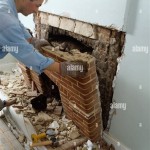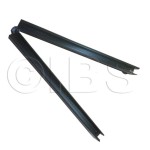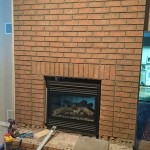What Do You Clean a Brick Fireplace With?
Maintaining a brick fireplace involves regular cleaning to remove soot, ash, and other debris that accumulate over time. Choosing the right cleaning agents and methods is crucial for preserving the brick's integrity and appearance. The buildup of creosote, a flammable byproduct of burning wood, also necessitates specialized cleaning techniques to prevent fire hazards. The following explores the various cleaning options available for brick fireplaces, detailing their application and effectiveness.
Assessing the Fireplace's Condition and Soiling
Before commencing any cleaning process, it is essential to assess the condition of the brick and the extent of the soiling. Different types of stains and levels of buildup require different approaches. Common issues include soot accumulation, creosote deposits, mineral stains (efflorescence), and general grime. Older bricks may be more porous and susceptible to damage from harsh chemicals or abrasive cleaning methods. A visual inspection will determine the specific cleaning products and techniques that are best suited for the fireplace. It is also prudent to test any cleaning solution on a small, inconspicuous area first to ensure it does not discolor or damage the brick.
The type of wood burned in the fireplace also influences the nature of the buildup. Softwoods, like pine, tend to produce more creosote than hardwoods, such as oak or maple. Regular chimney sweeps and proper wood selection can significantly reduce the amount of cleaning required. Prior to cleaning, the fireplace should be thoroughly cooled, and any loose debris, such as ash, should be removed with a brush and dustpan or vacuum cleaner. The surrounding area should be protected with drop cloths to prevent staining or damage from cleaning solutions.
DIY Cleaning Solutions for Brick Fireplaces
Several effective DIY cleaning solutions can be prepared using readily available household ingredients. These options offer a cost-effective and environmentally friendly alternative to commercial cleaners. However, it is important to exercise caution and follow safety guidelines when using any cleaning solution, even those that are homemade.
Vinegar and Water Solution: A mixture of equal parts white vinegar and water can be used to clean light soot stains and general grime from brick surfaces. The acidic properties of vinegar help to dissolve dirt and grease. Apply the solution with a sponge or brush, scrub gently, and then rinse with clean water. For stubborn stains, the solution can be left to dwell on the surface for several minutes before scrubbing. It is crucial to ensure that the vinegar solution does not penetrate deeply into the brick, as prolonged exposure to acid can potentially damage porous materials. Thorough rinsing is necessary to remove any residual vinegar.
Baking Soda Paste: Baking soda is a mild abrasive that is effective for removing stubborn stains and soot deposits. To create a cleaning paste, mix baking soda with water until a thick consistency is achieved. Apply the paste to the stained areas, let it sit for several minutes, and then scrub gently with a brush. Rinse with clean water. Baking soda is particularly useful for neutralizing odors and removing grease. Its gentle abrasive action makes it less likely to damage the brick surface than more aggressive cleaning agents. The paste can be applied multiple times if necessary, allowing sufficient dwell time for the baking soda to penetrate the stains.
Dish Soap and Water: A solution of mild dish soap and water can be used to clean general dirt and grime from brick fireplaces. This is a gentle cleaning option that is suitable for regular maintenance. Apply the solution with a sponge or brush, scrub gently, and then rinse with clean water. Ensure all soap residue is removed to prevent a sticky or slippery surface. Dish soap is particularly effective for removing grease and oil stains. Choose a product specifically formulated for tough grease removal for best results. Rinse all surfaces thoroughly with clean water, then allow to air dry. Multiple applications may be needed for heavily soiled areas.
Commercial Cleaning Products for Brick Fireplaces
A wide range of commercial cleaning products are available for cleaning brick fireplaces. These products are specifically formulated to remove soot, creosote, and other types of stains. When using commercial cleaners, it is essential to follow the manufacturer's instructions carefully and to wear appropriate protective gear, such as gloves and eye protection. Always test the product on a small, inconspicuous area first to ensure it does not damage the brick.
Brick and Masonry Cleaners: These cleaners are formulated to remove efflorescence, mortar stains, and other types of mineral deposits from brick surfaces. They typically contain mild acids or detergents that dissolve the stains without damaging the brick. Follow the manufacturer's instructions for application and rinsing. These cleaners are often more effective at removing mineral deposits than DIY solutions, especially in areas with hard water. Always use adequate ventilation when applying these chemicals, and avoid contact with skin and eyes.
Creosote Removers: Creosote removers are designed to break down creosote deposits, which are a significant fire hazard. These products are available in various forms, including sprays, powders, and liquids. Apply the remover according to the manufacturer's instructions, and allow sufficient dwell time for the product to penetrate the creosote. Regular use of creosote removers can help to prevent the buildup of creosote and reduce the risk of chimney fires. Creosote removers are usually applied either from inside the firebox, or by a professional chimney sweep who will introduce the product from the roof. Follow the recommended dwell time before cleaning the area again. It is important to verify which methods and equipment are needed for rinsing and cleaning the residue, as this can vary depending on the type of product.
Soot Removers: Soot removers are designed to remove soot stains from brick surfaces. These products typically contain detergents and solvents that dissolve the soot. Apply the remover according to the manufacturer's instructions, and scrub gently with a brush. Rinse with clean water. Soot removers are generally effective at removing surface soot but may not be as effective for removing deeply embedded soot or creosote. Before using any soot remover, clear loose soot from the area with a brush or vacuum cleaner. This will prevent the surface from becoming excessively smeared when the remover is applied. Check the product specifications to see if repeated applications are needed for heavier soiling.
Cleaning Tools and Techniques
The right cleaning tools and techniques can significantly improve the effectiveness of the cleaning process and minimize the risk of damaging the brick. Gentle scrubbing with a soft-bristled brush is generally preferred over abrasive methods that can scratch or erode the brick surface.
Brushes: Use a soft-bristled brush to scrub the brick surface gently. Avoid using wire brushes or other abrasive brushes, as they can scratch or damage the brick. A nylon brush is a good option for general cleaning. Stiffer brushes may be needed for stubborn stains, but use caution to avoid damaging the brick. When using a brush, work in small sections and apply moderate pressure. Regular rinsing of the brush will help to prevent the spread of dirt and grime.
Sponges: Sponges are useful for applying cleaning solutions and rinsing the brick surface. Choose a sponge that is absorbent and durable. Avoid using abrasive sponges, as they can scratch or damage the brick. Sponges are particularly useful for cleaning crevices and corners. Squeeze out excess water from the sponge before applying cleaning solutions to prevent the solution from running down the brick. Rinse the sponge frequently to remove dirt and grime.
Pressure Washers: Pressure washers can be used to clean brick fireplaces, but caution is advised. High-pressure water can damage porous brick surfaces, especially if the brick is old or deteriorated. If using a pressure washer, use a low-pressure setting and a wide nozzle. Test the pressure washer on a small, inconspicuous area first to ensure it does not damage the brick. Avoid directing the water stream directly at the mortar joints, as this can erode the mortar. Pressure washers can be effective for removing loose debris and surface dirt, but they may not be as effective for removing deeply embedded stains. Ensure proper drainage when using a pressure washer to prevent water damage.
Effective cleaning of a brick fireplace depends on careful assessment, appropriate product selection, and gentle cleaning techniques. Whether using DIY solutions or commercial products, prioritizing the brick's integrity is paramount.

How To Clean Internal Bricks On A Fireplace Sharn S House

How To Clean Brick The Home Depot

Vane Cottage Chemical Brick Mortar Soot Cleaner 6

How To Clean A Fireplace Diy Basics

How To Clean Brick The Home Depot

How To Clean Fireplace Brick Monty S Vintage

Fireplace Cleaning Tutorial Kippi At Home

How To Clean Brick Fireplace Royal Stone Care

Mortar Wash Brick Fireplace Makeover Dimples And Tangles

How To Clean A Brick Fireplace
Related Posts








